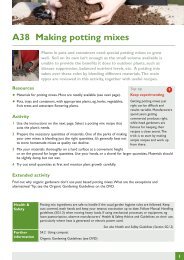A16 Building a garden path - Garden Organic
A16 Building a garden path - Garden Organic
A16 Building a garden path - Garden Organic
You also want an ePaper? Increase the reach of your titles
YUMPU automatically turns print PDFs into web optimized ePapers that Google loves.
<strong>A16</strong> <strong>Building</strong> a <strong>garden</strong> <strong>path</strong><br />
Resources<br />
•<br />
•<br />
•<br />
Paths should offer year round access to your growing areas as<br />
well as <strong>garden</strong> features like sheds. They needn’t be complicated or<br />
expensive, but should be well built for safety and durability. The<br />
following instructions illustrate how to make simple <strong>path</strong>s from<br />
grass, bark chip, gravel and paving.<br />
Tools including: spade, fork, shovel, wheelbarrow, soil rake, spirit level, <strong>garden</strong> line and canes<br />
Path surface materials (see below)<br />
<strong>Garden</strong> design showing the location of <strong>path</strong>s (see B4.3 for example plan)<br />
Activity<br />
1 Using the <strong>garden</strong> design as a guide, mark out the location and shape of the <strong>path</strong>s with <strong>garden</strong> line and canes.<br />
2 Follow detailed instruction on the next page as required<br />
a <strong>Building</strong> a grass <strong>path</strong><br />
b <strong>Building</strong> a bark chip or gravel <strong>path</strong><br />
c <strong>Building</strong> a paved <strong>path</strong><br />
Extended activities<br />
1 Prepare growing areas between <strong>path</strong>s (see B4.8 and B5.8).<br />
2 Organise a ‘<strong>path</strong>-making day’ by inviting pupils, parents and local people to help clear the space. See A1<br />
and A2 for ideas.<br />
Health &<br />
Safety<br />
Further<br />
information<br />
Choose a surface that allows safe access for all users. If unsure about the construction method,<br />
consult a builder. Follow Manual Handling guidance when moving bulky materials like gravel<br />
(B3.4). Be careful when using old kitchen knifes to cut turf edges, ensuring adult supervision.<br />
A1 Hosting an annual event<br />
A2 Organising a <strong>garden</strong>ing day<br />
B4.8 Removing weeds and grass<br />
B4.10 Making <strong>path</strong>s and surfaces<br />
B5.8 Digging<br />
See also Health and Safety Guidelines (Section B3.3)<br />
1
2<br />
Instructions for building a <strong>garden</strong> <strong>path</strong><br />
a <strong>Building</strong> a grass <strong>path</strong><br />
Grass <strong>path</strong>s can be made when digging out new beds<br />
in an existing lawn. When the bed is prepared, simply<br />
cut the lawn edge with a spade or ‘half-moon’ tool<br />
to define the <strong>path</strong> shape, using a wooden board or<br />
hosepipe for guidance if helpful.<br />
Preparing the ground for new grass<br />
1 Clear the area of weeds and any existing lawn<br />
in poor condition, eg weak growth, patchy, very<br />
mossy, etc. See A14. If the soil is very hard and<br />
compacted, dig the soil adding organic matter<br />
if required (see A9). A depth of 10-15cm is<br />
usually deep enough.<br />
2 Roughly level the soil using a fork, then walk<br />
slowly up and down the area with small<br />
footsteps to firm down the soil. Next rake the<br />
soil level to create an even surface ready for<br />
turves or grass seed.<br />
Laying turf<br />
P<br />
DSC5108 - 12 (close, with limited jumper)<br />
OR<br />
Close digging, eg DSC1527-28 CROP<br />
P<br />
DSC1417 - 20 (CROP to middle bit with rake)<br />
1 Unroll the turf on the soil, tapping it down with your hands so the grass roots are in contact with the<br />
soil beneath.<br />
2 Place a wooden board on the laid turf and walk across this to spread your weight evenly.<br />
3 Still standing on this board, lay the next turf alongside, staggering the joints, and ‘butting’ each turf<br />
tightly up against the next. Any gaps will otherwise dry out and go brown. Use an old kitchen knife to<br />
cut lawn edges as required.<br />
4 Water thoroughly after planting and then once or twice a week in hot weather until established.
Sowing grass seed<br />
Top tip<br />
Seasonal timing<br />
Laying turf and sowing seed is best done in autumn or spring when the warm and wet weather helps<br />
grass establish.<br />
1 Use a ‘stale seedbed’ method before sowing,<br />
ie prepare the ground and then leave it for a<br />
couple of weeks until weed seedlings germinate.<br />
Hoe these off and sow without further<br />
disturbing the ground.<br />
2 Using twine or bamboo canes mark out the<br />
area into one metre squares.<br />
3 Measure out sufficient seed for the sowing area<br />
(follow instructions on the seed packet). Divide<br />
the seed in two amounts. Using the metre<br />
squares as a guide, sprinkle the first half evenly<br />
over the soil in one direction and then sow the<br />
second batch at right angles to this.<br />
4 Lightly rake in. Water after planting and then<br />
once or twice a week in hot weather until<br />
established.<br />
P<br />
Hoeing<br />
DSC5098-102<br />
(close shot)<br />
P<br />
DSC1421 (crop a little)<br />
P<br />
DSC1432 - 35<br />
J<br />
3
4<br />
b <strong>Building</strong> a bark chip or gravel <strong>path</strong><br />
Top tip<br />
Adding durability to bark and gravel <strong>path</strong>s<br />
In areas of high pedestrian traffic, dig a deeper trench (10-20cm) and compact a 5-10cm layer of<br />
‘hardcore’ at the bottom<br />
1 Once the <strong>path</strong> is marked out on the soil,<br />
roughly clear the area of weeds or grass<br />
(see B4.8).<br />
2 Dig out the soil to a depth of 5-10cm to<br />
create a shallow trench. If free of weed roots,<br />
transfer the excavated topsoil into adjacent<br />
growing areas.<br />
3 Compact the soil surface at the bottom of the<br />
trench by stamping on the soil evenly across the<br />
whole length. Rake or scrape level with a spade<br />
as required.<br />
4 Lay a water-permeable and weed suppressing<br />
membrane fabric across the bottom of the<br />
trench, pushing into the sides and cutting<br />
to size.<br />
5 Spread a 5-10cm deep layer of gravel (eg 2cm<br />
grade) or bark chips and rake level<br />
J
c <strong>Building</strong> a paved <strong>path</strong><br />
Top tip<br />
Getting advice<br />
If unsure about the construction method, consult a builder or landscaping firm.<br />
1 Once the <strong>path</strong> is marked out on the soil, roughly clear the area of weeds and grass (see B4.8).<br />
2 Dig down to firm sub-soil or around 10-20cm. If free of weed roots, transfer the excavated topsoil<br />
into growing areas.<br />
3 Compact a 5-10cm layer of ‘hardcore’ (crushed rock) to create a level surface. Hardcore and<br />
compacting machines are available from builder’s merchants. Add a 2.5-5cm layer of sand and<br />
compact again.<br />
4 Lay strips or blobs of mortar (made by mixing water with one part cement and five parts sharp<br />
sand).<br />
5 Position the paving (eg brick, new or reclaimed paving slabs) on the mortar and tamp down, using a<br />
spirit level to check the level. Continue as required. Leave two days before walking on.<br />
6 If preferred, use ‘spacers’ between paving for 1cm gaps, but remove before the mortar sets. Fill the<br />
space between paving with a stiff mix of mortar, filling to just between the paved surface, and then<br />
brushing the paving clean.<br />
Different paved surfaces<br />
J<br />
5








